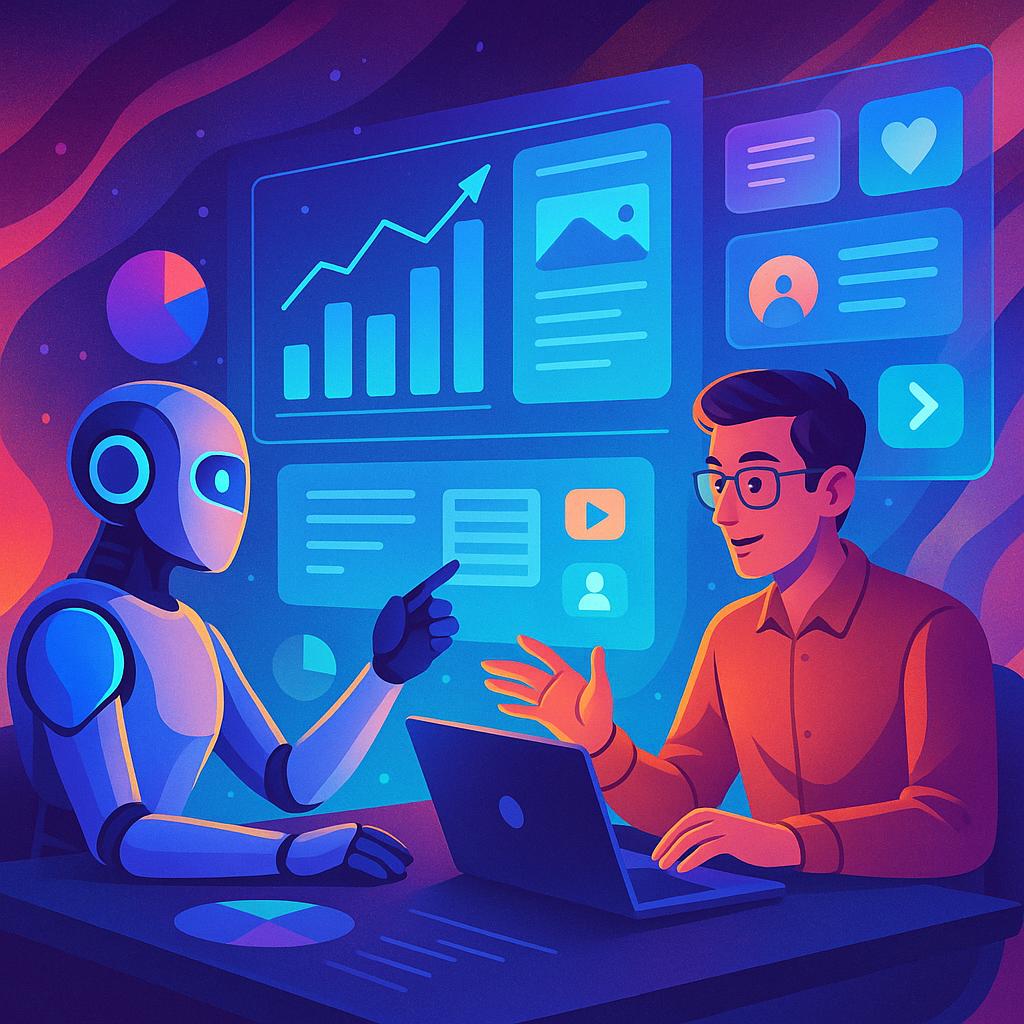AI has slipped into every corner of writing. Content marketing feels it more than most.
Try to find a campaign untouched by AI and you’ll struggle. It’s the name of the game now.
The appeal is obvious. AI makes the hard parts easier and the slow parts faster. Marketers use it to spot demand, sharpen messages, and scale what once took weeks. Because search, social, and inboxes keep changing, they need systems that can learn.
This article examines how AI and content marketing work together. It outlines the main benefits and applications and shows how to put them into practice.
Differences Between Traditional and AI-Driven Content Marketing?
Traditional methods rely on manual research, static personas, and batch publishing.
AI-driven programs learn continuously, test at scale, and adapt messaging to the moment.
The goal does not change. The path gets smarter and faster.
| Dimension | Traditional approach | AI-driven approach |
|---|---|---|
| Research | Manual keyword lists and interviews | Continuous intent and entity analysis |
| Ideation | Brainstorms and editorial gut feel | Topic models and search gap discovery |
| Production | Linear drafting and editing | Assisted drafting, variants, style controls |
| Personalization | Limited segments | Dynamic cohorts and real-time content |
| Testing | Occasional A/B tests | Always-on multivariate experiments |
| Governance | Manual checks | Policy-as-code and automated checks |
As programs mature, teams often mix both methods.
Key Benefits of Using AI in Content Marketing
1. Data-driven insights: Understanding audience behavior
AI surfaces patterns in queries, on-site behavior, CRM notes, and support tickets.
As a result, teams see which topics people demand, which objections stall deals, and which formats drive time on page.
Instead of guessing, analysts can group intents, entities, and questions. Then they prioritize content that meets those needs.
For repeatable insight, teams usually define a small set of north-star metrics such as qualified leads, assisted revenue, or subscriber retention.
With those targets in place, AI ranking and attribution models can inform what to make next and where to promote it.
2. Content personalization: Delivering the right message to the right person
Personalization works when the data and rules are clear.
AI can translate segments into message variants at the headline, module, or full-page level.
It can also time messages by recency, frequency, and monetary value to keep content helpful rather than noisy.
However, success depends on consent, brand tone, and creative guardrails.
Style guides, target-reading levels, and message boundaries reduce drift. Moreover, product teams should align with marketing so on-site prompts and emails reinforce each other, not compete.
Good personalization starts with helpfulness, then scales with automation.
3. Efficiency and scalability: Automating repetitive tasks
AI trims time on briefs, outlines, summaries, alt text, and metadata.
It also handles routine repurposing, like turning a webinar into clips, a transcript into a checklist, and a case study into slides.
That frees writers to focus on original research, interviews, and narrative craft.
To scale:
If your team wants a clearer picture of tools and workflows, explore pragmatic guides to content automation. Small wins stack up quickly.
Additionally, independent studies describe significant productivity gains when teams combine AI copilots with disciplined processes.
4. SEO optimization: AI for keyword research, topic clustering, and ranking predictions
AI helps cluster queries by intent, map entities, and spot gaps against competitors.
It can forecast which topics have the best chance to rank given your authority and resources.
It also suggests internal links and on-page improvements that support crawlability and clarity.
Two plays tend to work well:
- Use AI to compile and group query variants, then write for the actual questions users ask. This often surfaces overlooked long-tail opportunities.
- Organize content into a structured hub. Pillar and cluster strategy keeps topic depth high and navigation clean.
When teams want to optimize the technical chores, SEO automation frameworks can guide schema setup, internal linking patterns, and routine audits. Ground rules straight from the source, in Google Search Essentials documentation, emphasizes people-first content and reliable information.
AI Applications in Content Marketing
1. Content creation: Blog posts, product descriptions, ad copy, video scripts
Writers can use AI to draft outlines, angle options, and first passes. Editors then refine voice, add proof, and shape transitions.
Two safeguards keep standards high:
- Use prompt templates for tone, audience, and claims policy.
- Require a human to verify facts, sources, and brand voice before anything goes live.
A step-by-step workflow for editing AI content can help reduce errors and maintain voice consistency
When writers want better inputs, stronger prompts usually save hours; here is a concise playbook on creating effective AI prompts.
One of the best examples of combining AI with content production is Stryng, an all-in-one content marketing platform. It brings everything into one place: creating, editing, scheduling, and publishing. You can try Stryng for free, or connect with the team and let them handle your marketing activities for you.
2. Content curation: Recommending relevant articles, videos, or resources
Curation improves retention.
AI can score pieces by similarity, freshness, and engagement to assemble newsletters, resource hubs, or in-product education streams. It can also re-rank recommendations by user behavior in-session.
Editors should pin cornerstone content and down-rank items that fail brand or legal checks.
Furthermore, feedback loops such as “show me fewer like this” refine the model over time and reduce drift.
If a team publishes across many formats, clear tagging and consistent metadata give the model reliable signals. Then personalized feeds feel useful rather than random.
3. Audience segmentation and personalization
Segmentation advances past simple demographics.
AI can build cohorts around behaviors, content affinities, and deal stages. With that structure, marketers adjust sequences and on-site modules to match where a person is in the journey.
For B2B teams, firmographic market segmentation add clarity to messaging and CTAs. Clear segments help sales and success teams stay aligned with marketing.
Finally, remember to sunset segments that no longer perform. Models should not grow unchecked. Regular pruning keeps messaging crisp and relevant.
4. Chatbots and conversational marketing
AI chat can do more than answer FAQs. It can qualify leads, book demos, surface related content, and hand off to a human when the stakes rise.
Conversational journeys also reveal objections that blog posts and product pages can address.
To keep trust high:
- Disclose that users are chatting with AI.
- Log difficult conversations for team training.
- Update intents and responses monthly.
Teams experimenting with different assistants sometimes compare models and tools to fit their stack. If you are exploring options, a curated list of ChatGPT alternatives can help.
5. Predictive analytics for trends and engagement
Predictive models can estimate:
- Which topics will lift engagement next month
- When to refresh a post
- Which channels deserve more spend.
They can also flag decaying pages before rankings slip.
Marketers complement these models with directional tools to spot rising queries and seasonality.
Many teams reference Google Trends. Combined with analytics, this helps calibrate editorial calendars and promotion cadences.
Importantly, predictions guide decisions but do not replace testing. Teams still need control groups, holdouts, and clear definitions of success.
Future of AI and Content Marketing
The next wave will be less about raw generation and more about orchestration.
Retrieval-augmented generation, domain-specific fine-tuning, and policy-as-code will shape how content gets researched, created, checked, and distributed.
Three directions stand out:
- A content supply chain where briefs, drafts, checks, and approvals connect in one governed system.
- Trust layers that verify sources, cite claims, and watermark AI-assisted media.
- Personalization that relies on first-party data and privacy-safe modeling rather than third-party cookies.
Risk management will keep rising in importance. Practical frameworks, such as the NIST AI Risk Management Framework, help teams balance innovation with responsibility.
Meanwhile, marketers who combine automation with editorial judgment will stay competitive as channels evolve.
Summary
- By combining AI and content marketing, businesses can move from speculation to evidence-led decisions in research, creation, distribution, and measurement
- The largest gains appear in repetitive tasks, SEO planning, repurposing, and channel-specific adaptation.
- Personalization improves when first-party data, consent, and clear rules guide the models.
- Editorial standards, review checklists, and human judgment protect brand reputation.
- Clear data rights, attribution, and model usage policies reduce risk and increase trust.
- Results compound when teams pilot, learn, and then scale in phases rather than attempting a full overhaul at once.
Frequently Asked Questions
Q1: How should a team start with AI without risking quality?
A: Pick one workflow. Define inputs and outputs, then pilot with a small group. Keep a short review checklist for accuracy and tone. Expand only after the process proves stable for several weeks.
Q2: What metrics signal that AI content is working?
A: Watch engagement depth, qualified leads, assisted revenue, and content-influenced win rate. Track time saved per asset and error reductions to see if the workflow itself is improving.
Q3: Where does content automation fit best?
A: It shines on repeatable tasks such as briefs, outlines, summaries, descriptions, and repurposing. Use it to clear the busywork so writers can focus on interviews, research, and storytelling.
Q4: Can AI help with SEO automation without hurting credibility?
A: Yes, if targets are user-focused. Use AI for keyword grouping, internal links, and structured data. Then have editors verify claims, sources, and E-E-A-T signals before publishing.
Q5: Do chatbots replace human support or sales reps?
A: They handle simple questions and route complex ones. They also qualify leads and schedule demos. Humans still take over for nuanced issues, negotiations, and relationship building.



